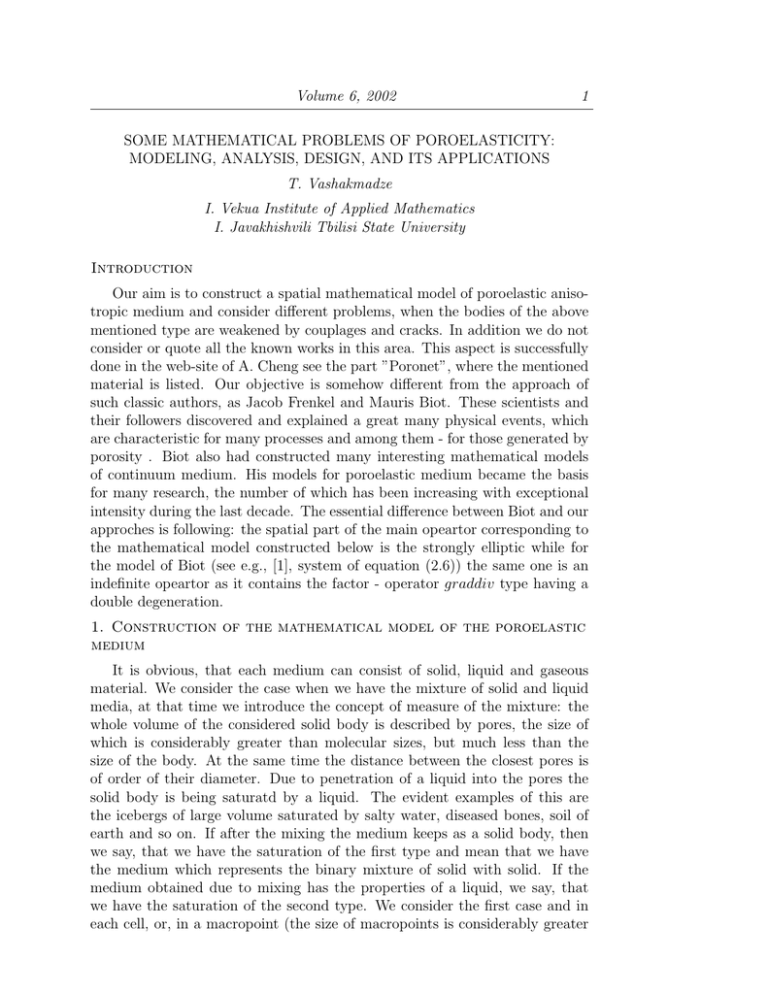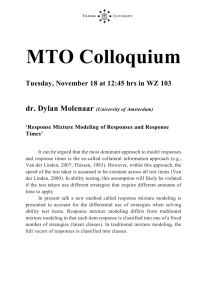Volume 6, 2002 1 T. Vashakmadze I. Vekua Institute of Applied Mathematics
advertisement

Volume 6, 2002
1
SOME MATHEMATICAL PROBLEMS OF POROELASTICITY:
MODELING, ANALYSIS, DESIGN, AND ITS APPLICATIONS
T. Vashakmadze
I. Vekua Institute of Applied Mathematics
I. Javakhishvili Tbilisi State University
Introduction
Our aim is to construct a spatial mathematical model of poroelastic anisotropic medium and consider different problems, when the bodies of the above
mentioned type are weakened by couplages and cracks. In addition we do not
consider or quote all the known works in this area. This aspect is successfully
done in the web-site of A. Cheng see the part ”Poronet”, where the mentioned
material is listed. Our objective is somehow different from the approach of
such classic authors, as Jacob Frenkel and Mauris Biot. These scientists and
their followers discovered and explained a great many physical events, which
are characteristic for many processes and among them - for those generated by
porosity . Biot also had constructed many interesting mathematical models
of continuum medium. His models for poroelastic medium became the basis
for many research, the number of which has been increasing with exceptional
intensity during the last decade. The essential difference between Biot and our
approches is following: the spatial part of the main opeartor corresponding to
the mathematical model constructed below is the strongly elliptic while for
the model of Biot (see e.g., [1], system of equation (2.6)) the same one is an
indefinite opeartor as it contains the factor - operator graddiv type having a
double degeneration.
1. Construction of the mathematical model of the poroelastic
medium
It is obvious, that each medium can consist of solid, liquid and gaseous
material. We consider the case when we have the mixture of solid and liquid
media, at that time we introduce the concept of measure of the mixture: the
whole volume of the considered solid body is described by pores, the size of
which is considerably greater than molecular sizes, but much less than the
size of the body. At the same time the distance between the closest pores is
of order of their diameter. Due to penetration of a liquid into the pores the
solid body is being saturatd by a liquid. The evident examples of this are
the icebergs of large volume saturated by salty water, diseased bones, soil of
earth and so on. If after the mixing the medium keeps as a solid body, then
we say, that we have the saturation of the first type and mean that we have
the medium which represents the binary mixture of solid with solid. If the
medium obtained due to mixing has the properties of a liquid, we say, that
we have the saturation of the second type. We consider the first case and in
each cell, or, in a macropoint (the size of macropoints is considerably greater
2
Bulletin of TICMI
than the size of pores, but much less than the size of body) we consider two
tensors of tension and deformation corresponding to components of mixture
and two displacement vectors. In addition, writing their connection rule, we
base on experimental works of Biot, Frenkel. For the mixture of solid body
and a liquid Biot introduced the tensors of tension and deformation σ ij and
εij ([2], F. (61)-(71)), which characterizes the mixture, as a whole medium. If
σ is an obtainable tensor for the mixture, then it is clear, that
σ = σ + (σ − σ),
(1.1)
where σ is a tension tensor of the solid body. If in the result of this process
the mixture of a solid body and a liquid remains as a solid body, then for
this description it is necessary to introduce the quantities, which generally
are characteristics of a solid body. Thus, as mentioned above, we consider the
case, when the interaction of a solid body and a liquid generates the solid-solid
mixture which, if it is only a mechanical mixture, is less rigid than the initial
body. When in the mixture besides the mechanical one there exist chemical
and other processes, it is available to obtain the mixtures of higher rigidity.
The analogous picture must take place when the mixture of a solid body and
a liquid transforms into the liquid, that is the solid body melts. In this case
the mixture is called a mechanical mixture, if its viscosity is more than the
viscosity of the given liquid. Thus, while constructing the mathematical model
of binary mixture it is necessary to consider its prehistory.
2. The basic system of three-dimensional equations with respect
to spatial variables
We denote the domain in the three dimensional Euclidean space R3 by
Ω. In the Cartesian coordinates the point is denoted by x = (x1 , x2 , x3 ) or
(x, y, z). Time changes in the interval t ∈ (0.T ), QT = Ω × (0, T ).
Thus, in each point of the mixture (macropoint) we consider the following
average quantities
σ = (σ11 , σ22 , σ33 , σ32 , σ31 , σ21 )T ,
u = (u1 , u2 , u3 )T ,
ε = (ε11 , ε22 , ε33 , ε32 , ε31 , ε21 )T ,
p = (p11 , p22 , p33 , p32 , p31 , p21 )T ,
ζ = (ζ11 , ζ22 , ζ33 , ζ32 , ζ31 , ζ21 )T ,
w = (w1 , w2 , w3 )T ,
where for the components of the deformation εij , ζij we have the formulas
εij =
1
(ui.j + uj,i + uk,i uk,j ) ,
2
ζij =
1
(wi.j + wj,i + wk,i wk,j ) .
2
(2.1)
The equilibrium equations for the mixture have the following form
(
∂j (σij + σkj ui,k ) = ∂tt (ρ1 ui + ρ2 wi ) + fi ,
∂j (pij + pkj wi,k ) = ∂tt (ρ2 ui + ρ3 wi ) + µη ∂t wi + ϕi , (x, T ) ∈ QT ,
(2.2)
Volume 6, 2002
3
where f = (f1 , f2 , f3 )T , ϕ = (ϕ1 , ϕ2 , ϕ3 )T are the vectors of volume forces, ρi
are densities, and the quantity µη is defined analogously to [1].
Instead of law (5.1) of [1] we define the Hooke’s type law (basing also on
the experimental data of A. Cheng [3]) as follows:
σ = Bε + Cζ,
p = Cε + M ζ,
(2.3)
(x, t) ∈ QT ,
(2.4)
pii = Ci ε + Mi ζ,
(2.6)
where B, A = B −1 - are rigidity and pliability 6 × 6 symmetric matrices,
respectively. C = {cij }6×6 , M = {mij }6×6 - are also symmetric matrices.
As we mentioned above, we will mean, that in each point of the body passes
at least one plane of flexible symmetry, which is parallel to Ox1 x2 plane. That
is to say, that in matrices C and M there are at most 13 constants not equal
to zero and
bi4 = bi5 = b46 = b56 = ci4 = ci5 = c46 = c56 = mi4 = mi5
(2.5)
= m46 = m56 = 0.
From (2.3) and (2.4) we have
σii = Bi ε + Ci ζ,
σij = B9−(i+j) ε + C9−(i+j) ζ,
pij = C9−(i+j) ε + M9−(i+j) ζ,
i 6= j,
where Bi , Ci , Mi - are i-th lines of corresponding matrices.
Let us introduce the following notations
τij = (σij , pij )T ,
∈ij = (εij , ζij )T ,
Ui = (ui , wi )T ,
(2.7)
(2.8)
On the basis of the introduced notations and assumptions (2.5) the equilibrium equations (2.2) and relations (2.3), (2.4) are written in the following
form
∂j (τij + τkj Ui,k ) = ρ∂tt Ui + ρ0 ∂t Ui + Fi ,
τii = Ai1 ∈11 +Ai2 ∈22 +Ai3 ∈33 +Ai6 ∈12 ,
τα3 = A6−α
i = 1, 2, 3,
∈32 +A6−α ∈31 ,
bmn cmn
cmn mmn
!
,
ρ=
ρ1 ρ3
ρ3 ρ2
!
,
ρ0 =
(2.10)
(2.11)
τ12 = A16 ∈11 +A26 ∈22 +A36 ∈33 +A66 ∈12 ,
where
Amn =
4
(2.9)
0 0
0 µη
!
(2.12)
, Fi = (fi , ϕi )T.
Symbol denotes the following operation
(a1 , a2 )T (b1 , b2 )T = (a1 b1 , a2 b2 )T .
Furter, in the main part of this lecture we reported also the two-dimensional
new models of von Karman-Reissner type systems of differential equations with
variable thickness constructed by methods of Ch.1, [4].
4
Bulletin of TICMI
REFERENCES
[1] Biot M.A., Generalized Theory of Acoustic Propagation of Porous Dissipative Media.
J. Acoust. Soc. Am. v.35, No.5, part 1, 1962, pp. 1254-1264
[2] Biot M.A. Nonlinear and Semilinear Rheology of Porous Media. J. Geophys. Res.
78, 1973, pp. 4924-4937
[3] Cheng A.H.-D. Material Coefficients of Anisotropic Poroelasticity. Inf. J.Rock Mech.
Min. Sci., v. 34, No.2, 1997, pp. 199-205
[4] Vashakmadze T., The theory of Anisotropic Elastic Plates. Kluwer Acad. Publ.
Dortrecht-Boston-London, 1999
Recieved October 15, 2002; revised November 25, 2002; accepted December 8, 2002.



